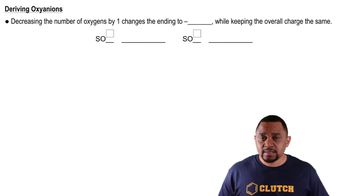In the Lewis structure shown here, A, D, E, Q, X, and Z represent elements in the first two rows of the periodic table. Identify all six elements so that the formal charges of all atoms are zero.
Ch.8 - Basic Concepts of Chemical Bonding
Chapter 8, Problem 10b
Consider the Lewis structure for the polyatomic oxyanion shown here, where X is an element from the third period (Na - Ar). By changing the overall charge, n, from 1- to 2- to 3- we get three different polyatomic ions. For each of these ions (b) determine the formal charge of the central atom, X;
 Verified step by step guidance
Verified step by step guidance1
Step 1: Identify the central atom X and its possible oxidation states. Since X is from the third period, it could be any element from Na to Ar.
Step 2: Write the general formula for the polyatomic oxyanion, considering the central atom X and the surrounding oxygen atoms.
Step 3: Use the formula for formal charge: \( \text{Formal Charge} = \text{Valence Electrons} - \text{Non-bonding Electrons} - \frac{1}{2} \times \text{Bonding Electrons} \).
Step 4: Calculate the formal charge of the central atom X for each ion with charges 1-, 2-, and 3-. Adjust the number of electrons accordingly for each charge.
Step 5: Compare the formal charges for each ion to understand how the change in overall charge affects the formal charge of the central atom X.

Verified video answer for a similar problem:
This video solution was recommended by our tutors as helpful for the problem above.
Video duration:
4mWas this helpful?
Key Concepts
Here are the essential concepts you must grasp in order to answer the question correctly.
Lewis Structures
Lewis structures are diagrams that represent the bonding between atoms in a molecule and the lone pairs of electrons that may exist. They help visualize the arrangement of electrons and the connectivity of atoms, which is crucial for understanding molecular geometry and reactivity. In the context of polyatomic ions, Lewis structures also illustrate how charges are distributed among atoms.
Recommended video:
Guided course

Lewis Dot Structures: Ions
Formal Charge
Formal charge is a theoretical charge assigned to an atom in a molecule, calculated based on the number of valence electrons, the number of non-bonding electrons, and half the number of bonding electrons. It helps in determining the most stable structure of a molecule or ion by minimizing the formal charges across the atoms. Understanding formal charge is essential for evaluating the stability and reactivity of different polyatomic ions.
Recommended video:
Guided course

Formal Charge
Polyatomic Ions
Polyatomic ions are charged species composed of two or more atoms covalently bonded together, which can carry an overall positive or negative charge. The charge arises from the loss or gain of electrons, and different charges can lead to the formation of various ions from the same central atom. Recognizing how the charge affects the Lewis structure and formal charge is key to analyzing the properties of these ions.
Recommended video:
Guided course

Polyatomic Ion Variations
Related Practice
Textbook Question
2
views
1
rank
Textbook Question
The molecule shown here is styrene, C8H8, a benzene derivative that is used to make a number of polymers, including polystyrene. The shorthand notation for the benzene ring (described in Section 8.6) is used. Three of the carbon–carbon bonds are numbered in the structure.
a. Which of the three bonds is the strongest?
b. Which of the three bonds is the longest?
c. Which of the three bonds is best described as halfway between a single and a double bond? [Sections 8.6 and 8.8]
Textbook Question
(a) True or false: An element's number of valence electrons is the same as its atomic number.
Textbook Question
(b) How many valence electrons does a nitrogen atom possess?
1
views
Textbook Question
(c) An atom has the electron configuration 1s22s22p63s23p2. How many valence electrons does the atom have?
2
views
